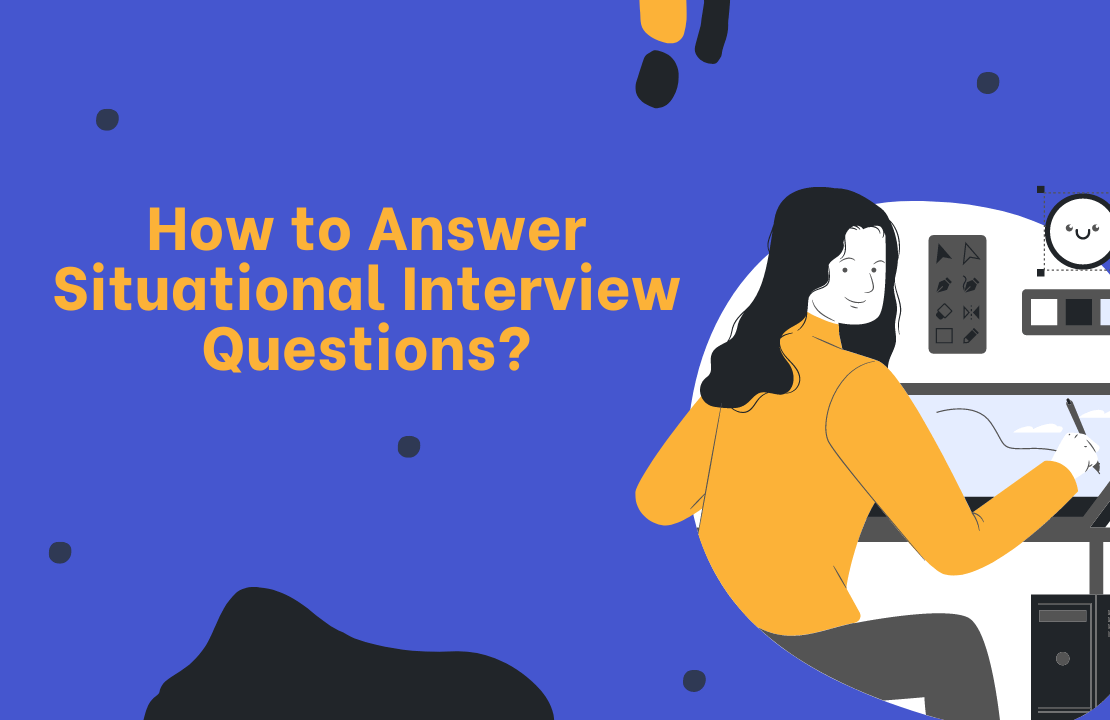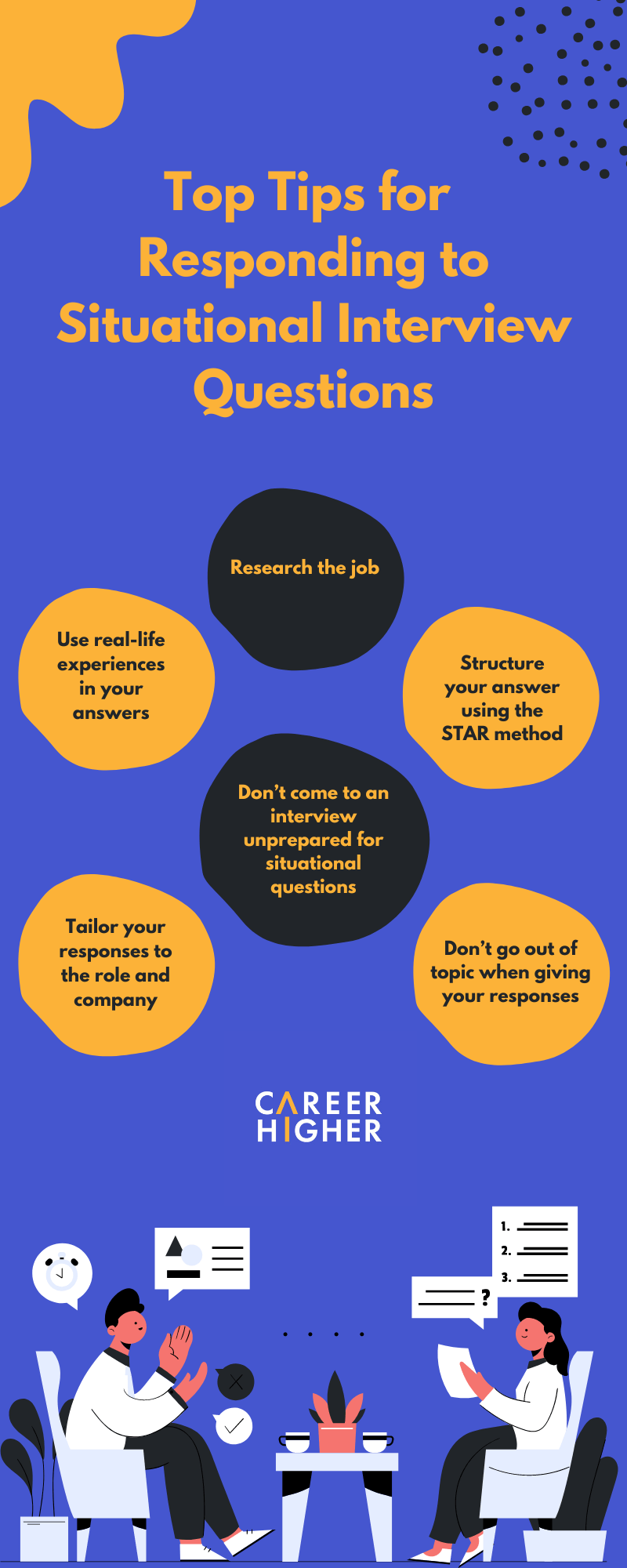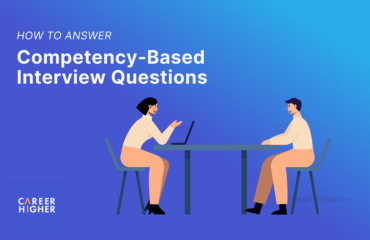Table of Contents
- Why Do Employers Ask Situation-Based Interview Questions?
- Tips and Tricks for Responding to Situational Interview Questions
- Examples of Situational Interview Questions and Answers
- Example 1: How would you convey a complex idea to a client who was already upset?
- Example 2: What would you do if you knew that the direction provided by your manager was incorrect?
- Example 3: How would you respond if you were not satisfied with a certain aspect of your job?
- Example 4: What would you do if the priorities of a nearly completed project changed abruptly?
- Example 5: What would you do if you were asked to collaborate with a colleague on a task but you two couldn’t seem to come to an agreement?
- Example 6: What would you do if you were asked to take on a task you have not done before?
- Example 7: If you made an error and no one noticed, what would you do?
- Example 8: What would you do if you’ve been assigned too many to-do items, making your workload overwhelming?
- Example 9: Imagine an instance in which you are working on a project with tight timelines, and a team member is behind schedule with a critical deliverable. How would you react to the situation?
- Example 10: How would you manage a client who’s asking an impossible request?
- Example 11: How would you convince someone to view your side of things?
- Example 12: Imagine a situation when your job had to go through significant changes? How would you adjust?
- Example 14: “What would you do if the performance of your subordinate team member fell short of expectations?”
- Example 15: “What if you failed at work? How would you handle it?
- Example 16: “What if you were put in a high-pressure situation? How would you go through it?
- Example 17: “What would you do if you had to make a good impression on a client?
- Example 18: “What if you observed a problem at work? How would you go about solving it?
- Example 19: “What if you had to make a challenging decision at work? What steps would you take to make it?
- Example 20: “How would you handle a situation where you had to disagree with your manager?
Situational interview questions or scenario-based interview questions are designed to assess how candidates may handle hypothetical situations at work. Contrary to behavioral interview questions that regard real prior job experiences, situational interview questions deal with fictitious scenarios that might possibly occur in the workplace in the future. Typically, they begin with phrases like, “What would you do if…”, “How would you respond if…”, and “How would you handle…”.
Despite being common in job interviews, these types of questions still throw candidates a curveball. This is due to the fact that situational questions are harder to anticipate. In some cases, applicants may be asked to address situations they have not encountered before. Hence, interview preparation is imperative to your nail your response. In this article, we will discuss some helpful tips on how to answer situational interview questions.
Why Do Employers Ask Situation-Based Interview Questions?
To provide interviewers with a solid response, it is crucial to understand why they ask this question and what they want to learn from your answer. Although past work experiences are essential, employers are also interested in learning your compatibility with the workplace culture and your likelihood of succeeding in the position. By asking the question, interviewers gain vital insights into your thought process and assess your problem-solving and critical thinking abilities.
The situation-based interview questions provide interviewers with a better understanding of your ability to act in certain situations and handle challenging issues in the workplace. This allows them to predict and evaluate your future job performance if hired. Essentially, employers want to know how well you will do with the job and the organization. So, how do you pass situational interview questions? We’ll talk about that in the next section.
Tips and Tricks for Responding to Situational Interview Questions
Thinking about how you will respond to common situational interview questions beforehand can give you the best chance of landing your dream job. It allows you to come up with a strong response and give your best performance during the interview. Below are some tips and tricks to help you prepare and structure your answers effectively.
1) Understand the job requirements
Situational interview questions aim to assess your suitability for the job. To give you the best chance of success, it is important to demonstrate how your competencies and abilities can add value to your potential employer. So, make sure to revisit and understand the job requirements before the interview. Then, think about how your background and skills align with your target job. This information is vital in effectively communicating relevant skills needed to overcome potentially challenging situations at work and perform well.
2) Incorporate real-life examples (when possible)
Situational interview questions might be hypothetical. However, that does not necessarily mean your responses need to be fictitious. If you have encountered and overcame a similar situation in your past job, we highly recommend mentioning that in your answer. This will provide interviewers with solid information on how you handle challenges in comparable scenarios, boosting your credibility. For example, you can say something like “I encountered a similar situation in my role at Company ABC,” followed by a step-by-step description of how you addressed the situation.
3) Structure your answer using the STAR method
STAR is an abbreviation that stands for situation, task, actions, and results. This method is an effective way to structure your speaking points in a logical and cohesive story. Furthermore, it enables you to deliver a succinct response that highlights the qualifications that make you the ideal applicant for the job. Let’s take a closer look at the breakdown of the STAR method.
- Situation – Start by briefly providing context around an obstacle or situation you experienced at work. What was the situation? Who were the people involved? Why did the situation take place at that particular time?
- Task – Then, detail your specific responsibilities. Give the interviewer a clear grasp of what you’re expected to do. This part of your answer should clarify your involvement in the situation and the background of the story.
- Actions – This part details your approach by providing a step-by-step description of how you resolved the situation. Explain your rationale behind your approach and how you identified solutions.
- Results – Discuss the results of your actions to close off your response. Make sure to highlight your strengths and focus on positive outcomes and learning experiences.
Common Mistakes to Avoid
Understanding common mistakes to avoid is just as important as learning how to answer situational interview questions. This helps in keeping you mindful of the things you should not do, which may diminish your chances of advancing to the next stage of the hiring process. Below are a few of them.
- Coming to an interview unprepared for situational questions
- Failing to tailor responses to the position and organization
- Providing unrealistic reasoning or responses
- Missing to include specific examples based on real-life experiences
- Giving responses that are out of context
Examples of Situational Interview Questions and Answers
Familiarizing yourself with common situational interview questions is one of the best ways to prepare for responses that will serve you best as a candidate. Although you may not know the exact situational questions an interviewer will ask, it will give you an idea of the type of questions to expect and how to answer them. Let’s take a look at some of them.
Example 1: How would you convey a complex idea to a client who was already upset?
Good Answer: “I encountered a similar situation in my role as a Software Project Manager at Company XYZ. The client was frustrated because the software program did not work as expected. As the leader of the project, I was expected to communicate with clients and address their needs. To pacify the situation, I listened to what the client had to say and understood their pain point from their perspective. Then, I presented my idea using a language that is simple and relatable to the client. As a result, I was able to obtain the client’s approval to execute the presented solution. The project delivered exceeded the client’s expectation, generating $XM in additional revenue for the company.”
Wrong Answer to Avoid: “I guess I would tell them that there’s nothing to be upset about as I’m here to help. I would explain the idea over and over again until they get it.”
Example 2: What would you do if you knew that the direction provided by your manager was incorrect?
Good Answer: “My managers have my utmost respect. But I also understand we are all fallible human beings who make errors. Typically, I would take the time to do the necessary research to confirm that my manager’s advice was indeed flawed. If I came to the conclusion that they were wrong, I would ask for a private discussion so that I could point out the mistake and explain why I disagreed. I experienced this situation in my previous role at Company ABC and took the same steps to resolve the problem. My manager appreciated me pointing out the error. In turn, we were able to address inaccuracies in our operation, saving the company $XM.”
Answer to Avoid: “I am the type of person who is honest and direct. So, I would tell him upfront that he was wrong.”
Example 3: How would you respond if you were not satisfied with a certain aspect of your job?
Good Answer: “I recognize that there is no such thing as a perfect job. In some cases, we may have duties and responsibilities that aren’t as thrilling as we want them to be. But if a part of my job was significantly making me unhappy, I would talk to my manager about the specifics of my position and how we might make the situation better for me. I’ve been lucky that my former managers have been really open to hearing my professional goals. This made me realize how important open communication is.”
Answer to Avoid: “If I’m not satisfied, I would look for a better opportunity. Life is short. So, we shouldn’t settle for something that does not make us happy.”
Example 4: What would you do if the priorities of a nearly completed project changed abruptly?
Good Answer: “As a Project Manager with Company X, I experienced a similar situation where the goals of an almost finished project I was diligently working on were changed. I communicated with the stakeholders to better understand the changes and their impact on the project. Then, I analyzed those priorities and decisions and identified ways to meet those goals without having to redo the project. In the end, we were able to complete the project within set timelines while maintaining alignment with the new goals.”
Answer to Avoid: “If it’s the management’s decision, there’s nothing I can do about it. So, I may have to redo the project or wait for further instruction.”
Example 5: What would you do if you were asked to collaborate with a colleague on a task but you two couldn’t seem to come to an agreement?
Good Answer: “At Company XYZ, another colleague and I were asked to collaborate on a client’s project. I saw right away that we have different approaches when it comes to handling client communications and follow-ups. Unlike my colleague, I prefer to follow up and communicate on the phone with the client at every stage of the process. To make our collaboration smoother, I discussed the matter with my coworker. We reached a compromise and agreed to hold a biweekly meeting with the client, rather than weekly. The project went smoothly, and the client was very happy with the outcome.”
Answer to Avoid: “If we couldn’t come to an agreement, there’s no point in working together. I would tell my manager about the situation and ask them to assign me a new partner in the project.”
Example 6: What would you do if you were asked to take on a task you have not done before?
Good Answer: “When I take on a new task, I always clarify expectations to understand where different priorities lie and what is required for the desired result. The next step is for me to assess the resources at my disposal to make sure I can handle the task properly. I check what support is available from my manager, as well as the availability of knowledge base, training, and an experienced colleague who can offer guidance. As I absorb knowledge from various sources and receive feedback, I typically find a successful way to accomplish the new task within the set expectations.”
Answer to Avoid: “When I’m asked to take on a new task, I always ask questions. I strive hard to learn as fast as I can.”
Example 7: If you made an error and no one noticed, what would you do?
Good Answer: “I believe it’s better to own up to any mistakes, even if they go unnoticed. This gives me the opportunity to fix the issue before it may otherwise turn into a bigger problem. In my role as a Data Analyst with Company X, I noticed an error in the historical data I submitted for the company’s annual budget planning. If not corrected, it would impact the benchmark reliability and budget decision-making. I informed my manager of the situation to get their support while I worked to fix the issue. In the end, I was able to correct and submit accurate data before the budget planning took place.”
Answer to Avoid: “If there is no harm done, I think no action is required from me. But if it’s a significant error, I would ask for help from my manager. I’m sure they can do something to fix it.”
Example 8: What would you do if you’ve been assigned too many to-do items, making your workload overwhelming?
Good Answer: “My previous employer was hit hard by the pandemic. So, our department was downsized by almost half. As a result, my workload increased significantly. I assessed our existing practices to identify any opportunities for enhancement. I found a way to consolidate multiple reports and summarize data in a more efficient way using Excel. This reduced the time it took to generate the daily reports, which made my workload a little bit less overwhelming.”
Answer to Avoid: “When my workload becomes overwhelming, I will do my best to finish everything as fast as possible. If I have to skip breaks at work, I would.”
Example 9: Imagine an instance in which you are working on a project with tight timelines, and a team member is behind schedule with a critical deliverable. How would you react to the situation?
Good Answer: “When I encountered a similar situation in my previous work at Company XYZ, I reached out to my colleague to understand the reason for running behind schedule. I found out that they had to deal with a critical issue that caused the delay. I offered assistance which my colleague appreciated. The work was completed in a day, and we were able to catch up on missed timelines.”
Answer to Avoid: “I would send a follow-up to remind my colleague of the timelines. If there is no response, I would inform my manager of the situation so my colleague would be forced to finish the work as soon as possible.”
Example 10: How would you manage a client who’s asking an impossible request?
Good Answer: “I was a Marketing Manager at Company ABC and had a meeting with a prospective client. They were requesting that we complete rebranding in one to two weeks, which is unrealistic. So, I took my time to explain the steps involved in the process, as well as the time it would take to complete each phase. I believe it’s critical for clients to understand the worth of the service they are receiving. After the meeting, the client understood the work that needed to be done in order to get the results they were looking to achieve. They decided to give us a month to work on the rebranding project. In the end, we were able to meet the set deadline, and the client purchased more services from us.”
Answer to Avoid: “I was a Marketing Manager at Company ABC and had to deal with a client with impossible demand. I told them the timeline they gave us to complete the project was unrealistic. As a result, the project did not push through.”
Example 11: How would you convince someone to view your side of things?
Good Answer: “At Company X, my manager was convinced that an existing product was still bringing revenue to the company. I gathered historical data on our sales and analyzed the revenue generated. Then, I created data visualizations that demonstrated how focusing on more popular products might boost the company’s sales. My manager accepted my idea and pitched it to the senior leaders. This helped the company generate $XM in additional sales in just three months.”
Answer to Avoid: “My manager at Company X believed that an existing product was still profitable. I knew this was not the case. So, I voiced my opinion and told them they were wrong.”
Example 12: Imagine a situation when your job had to go through significant changes? How would you adjust?
Good Answer: “When Company XYZ grew, I went from a Senior Customer Service Representative to a Team Lead. I read a lot of books about leadership and took team management training to be able to handle the new responsibilities more effectively. After a year in the role, I was awarded the Team Lead of the Year.
Answer to Avoid: “I was promoted from Senior Customer Service Representative to a Team Lead. Having to manage X team members is such a huge responsibility. However, I was able to adjust really well.
Example 14: “What would you do if the performance of your subordinate team member fell short of expectations?”
Good Answer: “When I was a Senior Manager with Company XYZ, I had a member in my team who was underperforming. We had a one-on-one meeting to identify what caused him to underperform. I listened to what he had to say to understand better and demonstrate my interest in his side of the story. Then, we identified the areas that required improvement and developed an action plan together. I closely monitored his performance, provided feedback, and offered support as needed. By doing this, his performance has greatly improved month-on-month. After six months, he was cited as one of the company’s top performers.”
Answer to Avoid: “I would talk to my subordinates and reiterate job expectations to ensure understanding. I would also create an action plan to push them to meet targets.”
Example 15: “What if you failed at work? How would you handle it?
Good Answer: “In my first month as a Senior Account Manager, I over-promised on a project deadline in an effort to impress a key customer. However, the team lacked the resources to complete the project by the timeframe I’d given. As a result, we lost the client. I took full responsibility of the loss and personally reached out to the client. Fortunately, the client made a decision to give us another go. This experience taught me how important it is to have reasonable expectations and to never promise more than I can deliver.”
Answer to Avoid: “When I was with Company XYZ, I promised a client more than I can deliver. So, we lost the client. I did my best to make up for the failure.”
Example 16: “What if you were put in a high-pressure situation? How would you go through it?
Good Answer: “I was asked to work on a critical coding project that had an earlier than usual deadline date. I set out time in my schedule to work on it, sought assistance when necessary, and made sure I had enough rest at home so I would have the energy I needed to concentrate all day. I had to put in a lot of effort, but I managed to finish it within the deadline.”
Answer to Avoid: “I was assigned to complete a coding project within a tight deadline. It was a stressful experience, but I was able to complete it successfully.”
Example 17: “What would you do if you had to make a good impression on a client?
Good Answer: “I had a client who was really picky. I gave him examples of several designs and asked him what he thought of each one. Then, I produced three alternative design concepts and sought his opinion on which one he liked the most and what alterations he desired. After some minor adjustments, he was very satisfied with the final design. He appreciated that I took the time to learn about his preferences. We ended up working together on three more designs for his company.”
Answer to Avoid: “My first high-profile client was very particular. I had to work on several designs and edits before I could come up with something he really liked.”
Example 18: “What if you observed a problem at work? How would you go about solving it?
Good Answer: “When I was an Administrative Assistant with Company ABC, I noticed that there was an unusually high frequency of printer paper orders. This shouldn’t be the case because I knew we had enough stashed away in the storage closet. So, I reorganized the printer papers in a way we could easily see where they were. We saved $XXX that year in paper cost.”
Answer to Avoid: “During my time as an Executive Assistant, I noticed an unusual volume of printer paper orders. I told my manager about it, so he could look into what the issue was.”
Example 19: “What if you had to make a challenging decision at work? What steps would you take to make it?
Good Answer: “When I was a project leader, we came to the realization that an earlier mistake would either compromise the quality of the finished product or force us to postpone the deadline. This would cause us to fail our department’s monthly target. I held a meeting with the team members to get their input and solicited feedback from my supervisor. Based on this, I considered the cons and pros myself. I felt that having a high-quality product would be more advantageous than releasing it on schedule. So, I decided to push back the deadline to which the team and management agreed.”
Answer to Avoid: “When I was working as a project leader, we found out that an earlier mistake would either cause the product quality or missed deadline. I chose to push back since I thought it would be more beneficial.”
Example 20: “How would you handle a situation where you had to disagree with your manager?
Good Answer: “When I was with Company XYZ, I noticed that our new project goals for the year wouldn’t be feasible based on my own experience with our clients. I went to my manager after the meeting and asked to talk about the goal. I clarified that I appreciated their motivation for wanting to do it. However, I didn’t think it would work best for our particular clientele. After I explained my case, she agreed with me and appreciated my help in saving the department’s time and money.”
Answer to Avoid: “While working with Company XYZ, I knew from experience that the new project goals were unrealistic. So, I told my boss I disagreed with the new targets, to which she eventually agreed.”
Situational interview questions are designed to provide prospective employers insight into the applicants’ ability to perform well in different environments and situations. The variety of situations and scenarios that interviewers can come up with is limitless, making it harder for candidates to predict. Preparing by familiarizing yourself with common situational interview questions and knowing how to answer them can help boost your chances of a successful interview.












